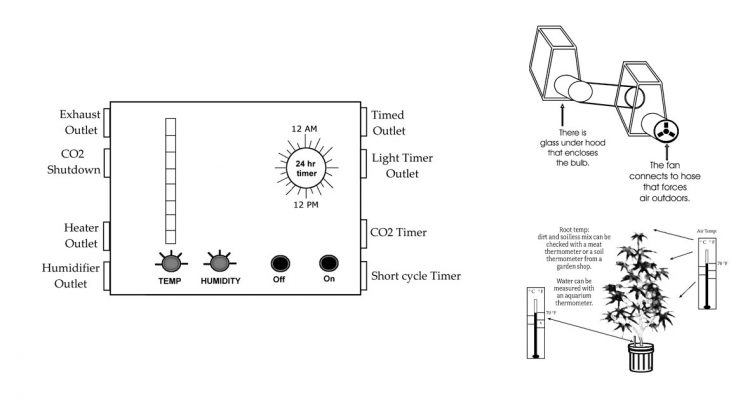Grow Room Lights and Lighting Accessories
Without light, the plants will not grow properly. With the proper amount of light at all times, plant growth can be maximized. If plants get too much light or too much heat, growth can be hindered or plants can burn out, showing a deformed flower and yellowing leaves.
Plant burnout normally happens when the most intense light from the source, like 1,000-watt sodiums, are located too close to flowers for prolonged periods. Often, only the odd flower of one plant burns out. This flower would be in the most light-intense part of the garden.
Too much light could mean other variables are not in place, such as adequate airflow or adequate C02 levels. However, some plants just have trouble adjusting to light intensity greater than the sun, considering it could be a new phenomena that the plant and its ancestors have never had to deal with.
When plants get too hot, the tissue hardens and changes color from green to yellow. Often, the next stage is turning from yellow to a crispy brown.
LED / Fluorescent Lights
In today’s market, the LED tubes look and perform much like the old school fluorescent light tubes, with some major exceptions like they use less than half of the energy. T8 and T5 daylight bulbs can be used for growing.
LED or Fluorescent lights work well for rooting clones and starting seedlings. However, seedlings that are more than five weeks old and vigorously growing cuttings should move on to more intense light, such as a 400, 600 or 1,000-watt metal halide to get better results, and to make work in the indoor garden more simple.
Plants rarely ever grow at the same rate. Therefore, constantly shuffling the height of fluorescent light fixtures and plants can be a pain in the ass. By comparison, a single halide bulb can be hung to distribute more intense light to the plants while taking up less space than fluorescent lights.
Envirolites fluorescents can be used with halides to add red light during flowering. Three 95-watt Envirolites can be used with each 1,000-watt halide. Envirolites can be used for vegetative, too. One light (1 inch above plants) can be used for every 2.6 square feet.
A grower can produce flowers from all types of LED or fluorescent lights, but, the better grow bulbs will give more usable light, even though they are more costly. Full spectrum daylight bulbs will work and so will the combination of a cool white and a warm white bulb in a fluorescent light fixture, but the light quality will be on the marginal side. Envirolites are top-quality fluorescents.
Metal Halide Lights (Good for Vegetative Room and Flower Room)
Metal halide lights are the most versatile lights for growing flowering plants. They come in all sorts of wattages, such as 150-watt, 250-watt, 400-watt, 600-watt and 1,000-watt. The 1,000-watt bulbs are the best deal. Halides come clear coated, phosphor coated, and with specialized light spectrums. Not only are some bulbs more powerful per watt than others, but some also give better light.
High-quality lights are available in the various watt outputs. Normally, better light costs more money. The phosphor-coated halide is one of the cheapest and most effective bulbs for vegetative growth and flowering. The color of the plants grown under the phosphor-coated bulb is pleasant on the eyes and nutrient deficiencies are easy to spot.
Metal halides generally produce more blue light than red light, although some brands produce adequate levels of all parts of the light spectrum, for instance Agrosun Gold and Durotest Optimarc.
In general, metal halides can be positioned closer to plants than sodium bulbs. Light intensity is one of the factors, but heat (for extended time periods) often does the most damage.
A grower can get away with using only halides during vegetative growth, but at least one HPS sodium light should be added per 2 to 3 halides during flowering. Another option is adding three Envirolites per each metal halide during flowering.
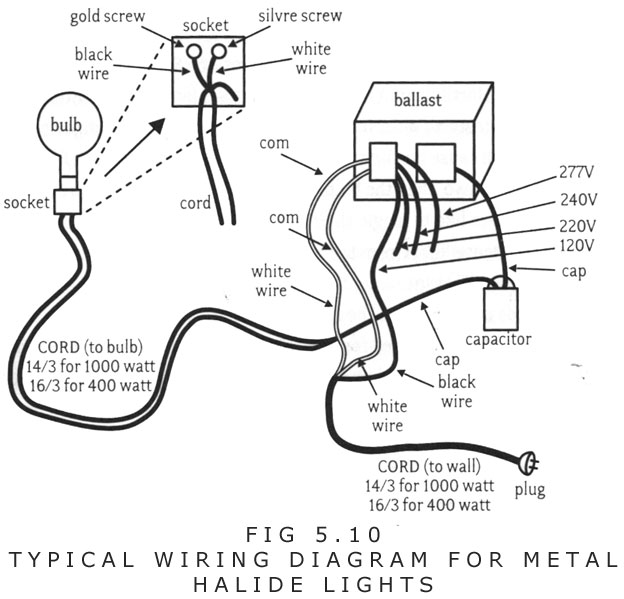
High-Pressure Sodium Lights (HPS)—Flower Room Bulb
High-pressure sodium lights emit plenty of red light, but not so much blue light. They tend to be more powerful than metal halide lights, but their lack of blue light makes them best used as a partner to the metal halide light.
However, used on their own, they can produce very effective results. Some sodium bulbs, such as the Son Agro Hortilux emit some bluer light. A plant can get within several inches of the hottest and most intense part of the bulb, but prolonged exposure to a near bulb will cause burning.
Often a plant located a few inches from a bulb is safe for a day or two, then the bulb or plant should be moved to prevent damage. Some growers like to juggle their bulbs all over the place so they can give plants lots of intense light (from top to bottom) without burning them.
Hoods reflect light into a concentrated area. The most common hoods are parabolic hoods and horizontal hoods. Hoods, which should always be used for vegetative growth, can be used for flowering, too. Good parabolic hoods reflect usable light over more space than horizontal hoods. For vegetative growth, that is a bonus. The bulbs must be able to be placed vertically when using a parabolic hood. (Figure 5.11)
Horizontal hoods reflect concentrated light downward. These are good units in a Sea of Green system, but horizontal hoods do not cover a lot of space. However, if hoods are raised, the lights can cover more area.
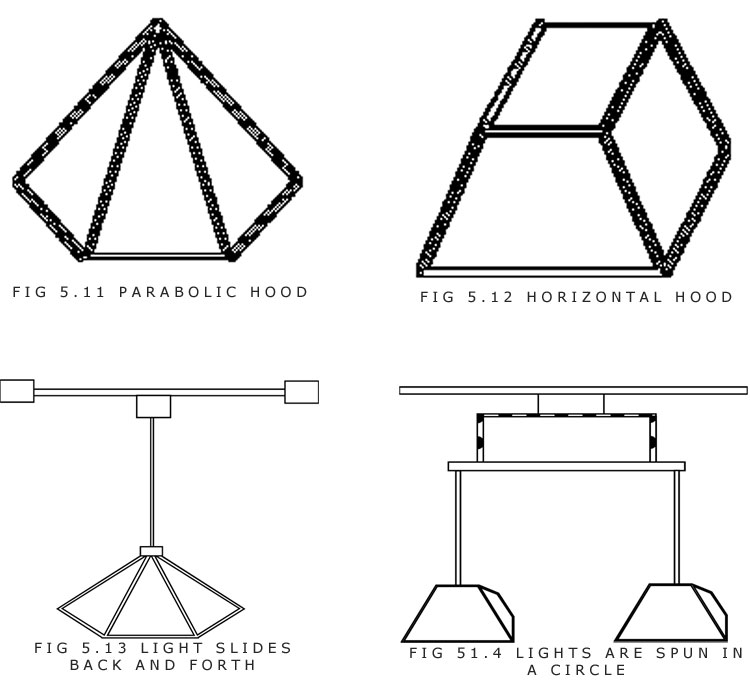
If bulbs are placed between large plants without hoods during flowering, more light can be utilized than if horizontal hoods are used. Even though the costs are a lot less, more maintenance is required. If horizontal hoods are used, the bulbs must be the type that can be placed horizontally.
Light Movers
Light movers such as the track move lights back and forth in a straight line so as to distribute the light over a larger area, and allow bulbs to get close to plants without burning the top shoots. Circular movers move lights in a circular motion. Plants can get close to the moving bulbs and a larger area can be covered.
The downside of light movers is that control is lost regarding bulb placement. For example, placing horizontal bulbs between plants can allow for larger plants to receive more light beneath the top sections. In this case, plants can get really close to a stationary horizontal bulb, if the bulbs have cold air fanned toward them.
Light movers are good for growers with limited electricity, especially when growing small plants for large tops.
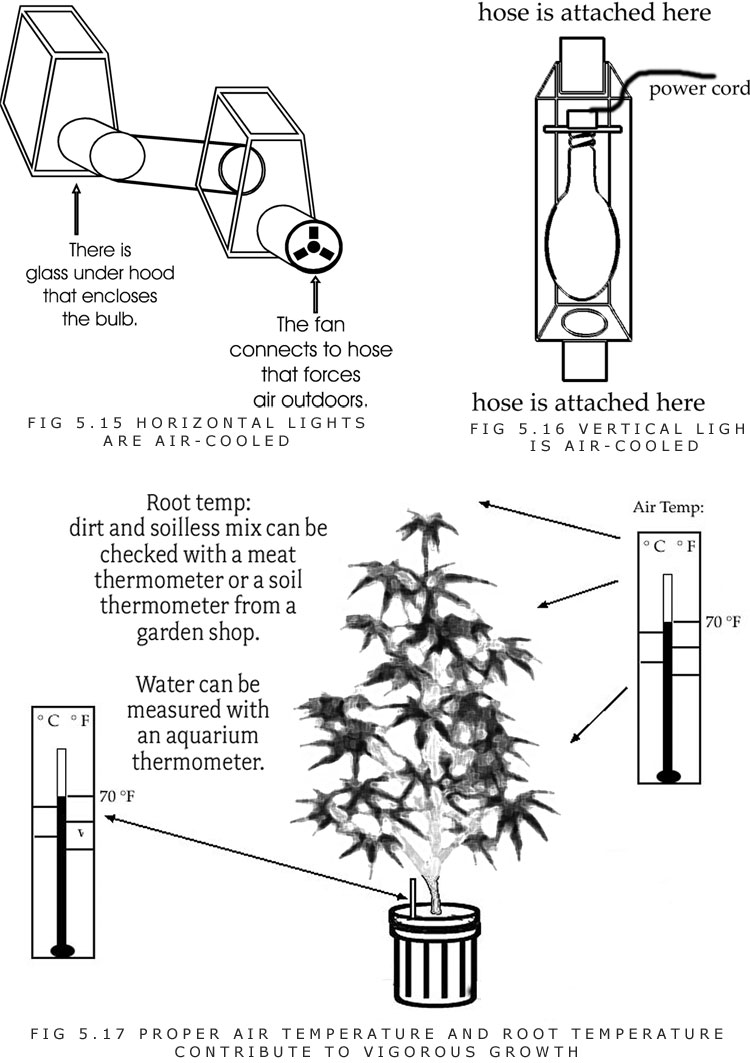
Air-Cooled Lights
Air-cooled lights are halides or sodium lights that are cooled with a special hood. These hoods work well and they are affordable. There are models with no hoods, too. (Figure 5.16)
Water-Cooled Lights
Water-cooled lights use water to cool the bulbs. This type of system is rather sophisticated. These lights are an option in a hot room if cool air is not available. Water-cooled systems cost a lot of money compared to other cooling methods such as air conditioners, heat exchangers, and air-cooled lights, and many complain that water-cooled systems can pose problems for those with less technological knowledge.
Temperature
Vegetative Room Air
It is recommended that a grower keep the air temperature between 70 to 80°F at all times. The air temperature should be similar or slightly cooler during the night.
Flower Room Air
It is recommended that a grower keep the air temperature between 65 to 80°F at all times. Some strains prefer cooler nights, while others may prefer a temperature similar to the light hours.
As with growing outdoors, all-around flowering temperatures should be kept slightly cooler during flowering.
Root Temperature
Root temperature should fall between 65 and 70°F. The water temperature in a hydroponic / aeroponic system can be used to give this root temperature. A root temperature greater than 70°F can encourage fusarium.
Chillers can be used to cool hydroponic reservoirs. Heat cords can be wrapped around reservoirs or taped to the bottom of a flood table in order to increase the water / root temperature.
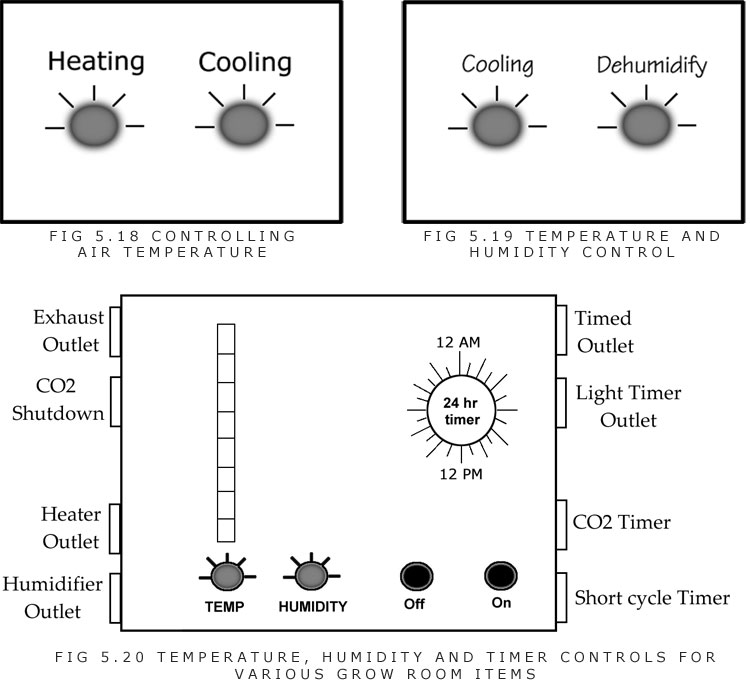
High-Tech Climate Control
Several companies, such as Grotek, Shiva Environmental Systems, and Green Air Products, offer various machines that run all or some of the grow equipment: exhaust fans, dehumidifiers, CO2 units, heaters, and grow lights. With one of these units, which run a few hundred bucks, temperature, CO2 , and humidity can be maintained at relatively accurate levels at all times.
These high-tech units work well for growers with big budgets that would rather hook up equipment that will do the job, than have to fiddle with the lights and other equipment such as exhaust fans to create an ideal climate.
Calculating Power Consumption
A lot of people think the power consumption used for indoor cultivation is totally outrageous, but it really isn’t. In fact, it is cheaper (while being highly productive) to run each room using the equipment described in this book than to use a small electric space heater in each room. The following is an example of calculating the energy consumed by a simple grow room as described in this chapter.
Power consumption in vegetative room (one day)
1. Exhaust fan 150-watts x 24 hours = 3.6 kW hours.
2. Two 400-watt halides 1,000-watts x 18 hours = 18.0 kW hours.
3. Oscillating fan 30-watts x 18 hours = .54 kW hours.
4. Total: 22.14 kW hours.
Potential energy competition:
Electric heater 1,500-watts x 24 hours = 36.0 kW hours.
In this case, an electric heater uses 13.86 more kW hours!
Multiplying watts by the hours of use will give the kilowatt hours. If the watts are not listed on the appliances, multiplying the volts and the amps listed on the backs of the appliances will give the wattage.
Multiplying kW hours by the electrical company’s price per kW hour will give the appliance cost. For example, an oscillating fan uses 30 watts and runs for 18 hours every day. Multiplying 30 watts by 18 hours will give 540 watt hours a day, or .540 kW hours a day.
Multiplying .540 kW hours by $.05 per kW hr = $.27 a day. Then, multiplying by 30 will give the monthly cost. The monthly cost in this case is $.27 x 30 = $8.10 for a 30-day month.


